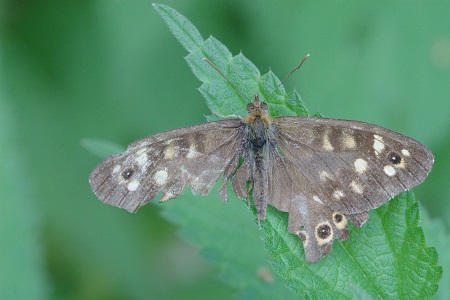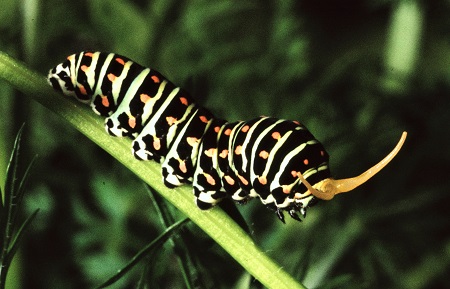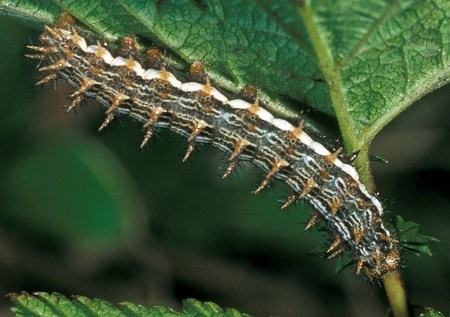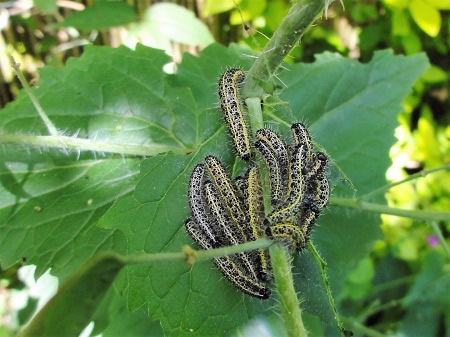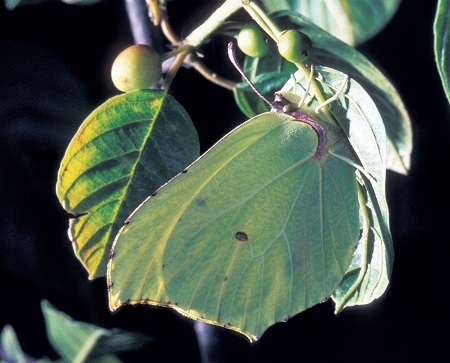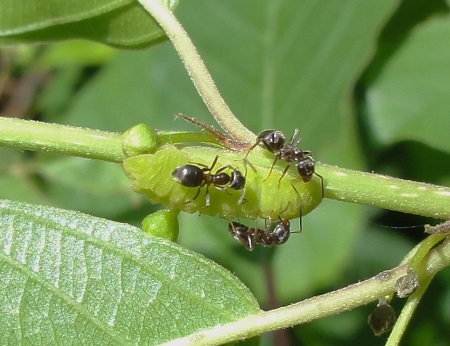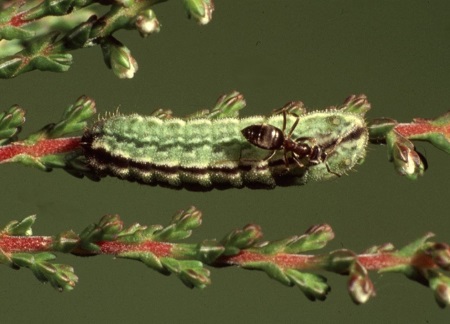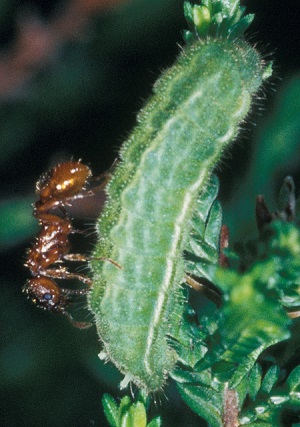|
10. Defence against threats
There are two types of threats against which defence is needed: biotic stress and endurance of physical stress. Biotic stress arises from predators, parasites and competitors. Physical stress is brought about by extreme weather conditions, drought, humidity and short of food. Caterpillars and adults defend themselves in their own particular ways.
It is clear that the occurrence of butterflies is connected with the availability of food and a mild climate while the presence of predators, parasites and competitors can limit their numbers. The butterfly species which live in this kind of environment are vulnerable to physical stress but they are specialised in defence against biotic stress. On the other hand there are species specialised in living under physical stress on sites where there is little danger from predators and parasites due to the harsh conditions. There are many species which exhibit both kinds of defence and these live usually in either a disturbed or changing locations. Such species have a nomadic lifestyle and they are always looking for new sites which are, at least temporarily, suitable. The ecologist Grime (1978) called these three types of life history strategies in plants competitors, stress-tolerators and ruderals.
Biotic stress
Larvae protect themselves in several ways: by being poisonous, by having spines or with a covering of long hairs. Another method is the deception of predators by mimicing inedible subjects or dangerous creatures; however, most of the larvae are masters of camouflage in order to make themselves invisible. In some cases a defence mechanism works against several threats as in the case of the thick coat of bristly spines in Melitaeini that protect the larva against attacks by ants and it also keeps the larva dry during rain.
|
|
Adult Pararge aegeria that escaped from a bird. Photograph (left): Jeroen Voogd ©.
Papilio machaon, caterpillar showing its osmeterium. Photograph (right): Frits Bink ©.
Defence against threats is well developed in adult butterflies by various ways of surviving and escaping from predation by birds. In the larval and adults stage there are different defences to survive biotic stress by predators that are visual hunters which learn how to recognise distasteful or poisonous potential prey. A well-known escaping technique is to mislead predators by mimicry or being less visible by camouflage. A special kind of defence is known from the larvae of species of the blues, coppers and hairstreaks (Lycaenidae) against predatory ants that has in many cases evolved into protection by ants, the myrmecophily. On the other hand, there is the specialisation to defy physical stress, the way of surviving harsh environment. However, threats from parasites and diseases have not produced any spectacular defences, only examples of victims are observed. Biotic stress: the larva of the swallowtail (Papilio machaon) have its weapon called the osmeterium. The larvae of many species of brush-footed butterflies (Nymphalidae) have protective spines as for example of the lesser marble fritillary (Brenthis ino).
Aposematic colouration in the large white (Pieris brassicae) is
a warning that the body contains poison and in adult butterflies, bright colours indicate that the wing scales may be distasteful.
Brenthis ino, caterpillar protected by spines. Photograph (left): Frits Bink ©.
Colourful larvae of Pieris brassicae. Photograph (right): Rosita Moenen ©.
|
|
Young larva of Papilio machaon. Photograph (left): Rosita Moenen ©.
Mimicry: this kind of defence is based on imitating distasteful objects like a bird dropping or inedible things like a leaf.
The young larva of the swallow tail (Papilio machaon) is black coloured with a white spot on its back and looks like a small bird dropping.
The larva of the comma butterfly (Polygonia c-album) mimics, in its last instar,
a big bird-dropping.
Larva of Polygonia c-album. Photograph (right): Frits Bink ©. |
|
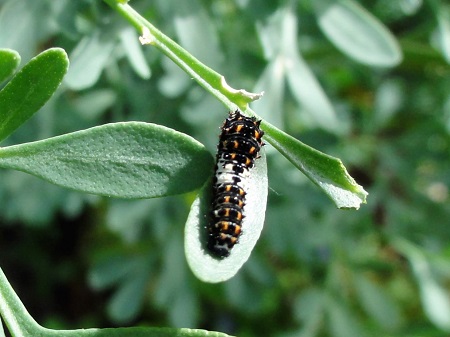 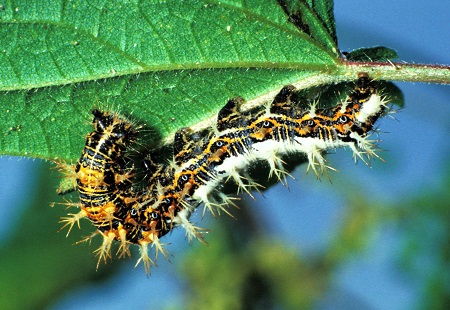
|
A very interesting subject is the use of colours and patterns in defence against biotic stress. A warning colouration makes the larvae as visible as possible, the aposematic colours of poisonous larvae. Or cryptic colouration, which makes the larvae as invisible as possible. There is also a type of colour pattern that protects by confusing predators. The golden or silvery spots on pupae of Nymphalinae and Heliconiinae are such patterns. However, this kind of defence can only work when the insects are scarce, since if abundant the predators will have learnt by trial and error. They will even select on it as soon they have learned that the object is very palatable.
Mimicry
Adults of some species have a remarkable resemblance to others which possess a defence against biotic stress. There are two ways of developing resemblance. Species with much the same appearance have the same defence. They have a bad taste or they are poisonous. This reinforces the effectiveness of this defence against predators which are visual hunters and which will learn whether or not an apparent prey is edible. In our region the whites (Pierinae) are an example of such a collective defence signal. The scales on their wings contain the repellent pterine. This type of mimicry was described by Fritz Müller in 1881.
The other type is to deceive the predator by a resemblance to an obviously inedible prey, whilst actually being edible. Among butterflies there are no examples of this kind of mimicry in our region, but in the tropics there occur many exponents of this type of mimicry which was described by Henry Bates in 1861.
|
|
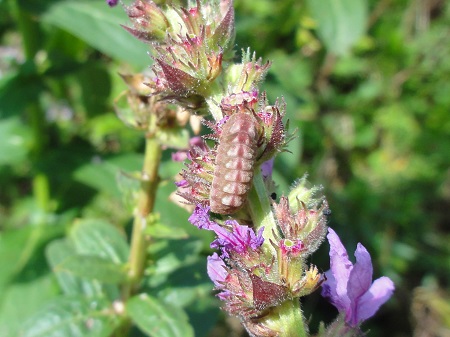 |
| |
The butterfly of the brimstone (Gonepteryx rhamni) looks like a leaf of its hostplant where it likes to rest.
Photograph: Frits Bink © |
Cryptic colouration makes the caterpillar of the holy blue (Celastirina argiolus) as invisible as possible.
Photograph:Rosita Moenen ©. |
Myrmecophily
The greatest invention in the development of systems of defence is a method to sooth dangerous ants. In the families Lycaenidae and Riodinidae there are species in which larvae are highly specialized in obtaining protection from ants. In a few species the larvae are even fully dependent on care by ants, in spite of that the adopted larvae may live inside the nest as a predator. They are wolves in sheep’s clothing, for example the large blue (Maculinea arion). The lycaenids’ larvae possess three kinds of organs to seduce the ants: micro-tubercles spread over the body which produce probably an appeasing smell, a dorsal honey-gland on the seventh abdominal segment that produces a sweet liquid when the larva is inspected by an ant and two retractable tentacles on the eight segment which extend quickly to call the ant back when it loses its attention to the larva. These tentacles will be retracted before the ant get a chance to bite them. Not all species have all of these organs. Those larvae living in areas where ants are uncommon will not possess all these mechanisms.
|
|
|
| |
Celastrina argiolus
Photograph: Rosita Moenen ©. |
|
Plebejus argus
Photograph: Frits Bink ©. |
| |
The larvae of the Lycaenidae are equipped to appease ants. They possess in many case three kinds of organs which function in relation with ants as in the holly blue
(Celastrina argiolus) and in the sliver-studded blue (Plebejus argus) and the begging for food in the ants nest by the larvae of the Alcon blue (Maculinea alcon).
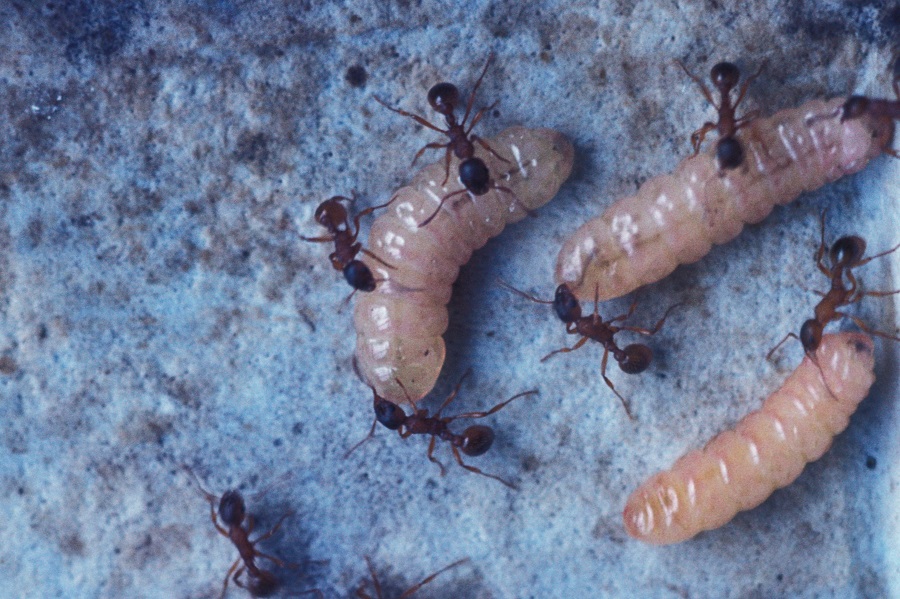
Maculinea alcon begging for food in the ants nest.
Photograph: Frits Bink ©.
|
|
Physical stress
Endurance of physical stress often works in the opposite way to defence against biotic stress. The type of defence may shift during larval development. A small newly hatched larva is usually more vulnerable than the fully grown ones. The tolerance to heat is a good example to demonstrate the differences varies between species. Larvae that live in woodland or tall herbs have a low tolerance to heat, their maximum temperature being about 28°C. In contrast those species living in heathland and short grassland are highly tolerant, such as those of the grayling (Hipparchia semele). Other butterflies can endure high temperatures, for example the silver-studded blue (Plebejus argus) has been shown experimentally to exhibit normal activity at an air temperature of 45°C.
| |
|
|
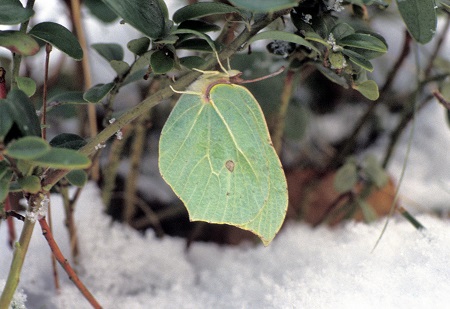 |
| |
Hipparchia statilinus in a drift sand in hot summer.
Photograph: Jeroen Voogd ©. |
|
Gonepteryx rhamnij hibernating exposed to frost.
Photograph: Frits Bink ©. |
| |
Living in harsh environment makes inhabitants austere in appearance and simple in way of life. Physical stress resistance can be recognized by the ability to perform the vulnerable phases of the life cycle under very hot, dry or during cold periods.
The tree grayling (Hipparchia statilinus) flies around in a drift sand in hot summer and the brimstone hibernates as adult exposed to rain and frost in a tussock or under a tiny shrub. |
The painted lady (Vanessa cardui) is an example of an extremely tolerant butterfly, it survives the heat of a dessert and also night frost; it has an almost worldwide distribution. A related species, the red admiral (Vanessa atalanta), is vulnerable and it migrates in the autumn to hibernate in the Mediterranean area because in wintertime it is too cold in the temperate region. The butterfly returns in spring because it becomes too hot in the Mediterranean region.
Butterflies that are able to endure physical stress can also live in environments with mild conditions but then they may suffer from biotic stress. On the other hand species resistant to biotic stress, may not be able to survive under physical stress.
|


